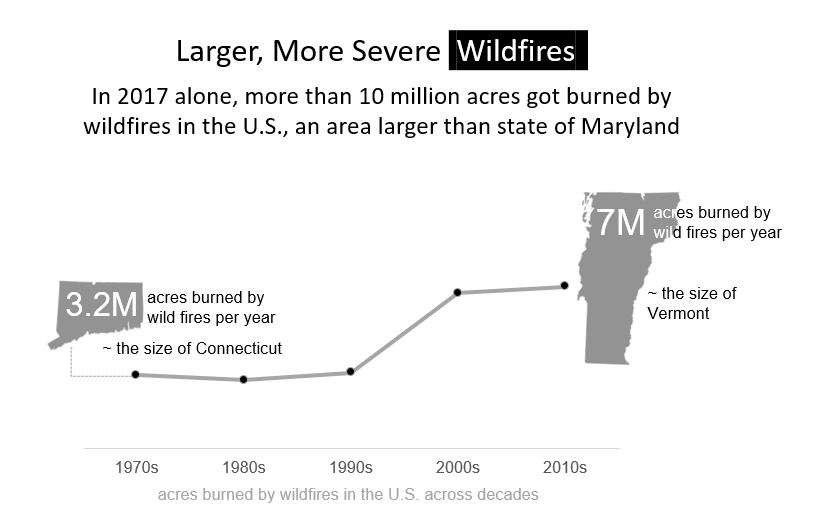Severe weather and power outages
By Aytek Yuksel, Content Marketing Leader - Power Systems

Preventing power outages caused by severe weather. Keeping the lights on. Keeping our critical facilities up and running when the most severe weather strikes. These challenges are not unique to one region of the U.S. Weather events, disasters and power outages occur in your state too.
Changing and unpredictable weather patterns create several severe weather events. These include hurricanes, wildfires, heat waves and snowstorms. These severe weather events often cause unexpected or planned power outages.
Is severe weather more common?
Hurricane activity across the United States' Gulf Coast has steadily increased since the 1980s. This is in comparison to the previous five decades. Moreover, the hurricanes are getting stronger and more disruptive to communities. They frequently require residents to temporarily relocate, often resulting in considerable financial losses for families.
Wildfires are getting larger and more destructive. Many estimations identify humans as the cause for nearly 85 percent of wild land fires. Meanwhile, the drier and hotter climate acts as a catalyst. It drives a trend toward larger and more severe wildfires.

We also experience more heat waves. Hot days are getting hotter and occurring more frequently. Heat waves are notoriously deadly for the very young and elderly, and dangerous for those living in urban areas or who work outdoors. The heatwave that hit Europe in 2003 claimed more than 70,000 lives.

Power outages caused by severe weather
These changing weather patterns and resulting severe weather also impact the electricity infrastructure. Hurricanes and wildfires bring down power transmission or distribution lines. These severe weather events force power plant closures. These cause power outages and leave consumers without electricity. Heat waves increase the usage of some power-hungry amenities including air conditioners. This causes a surge in the demand for electricity. This surge could result in an overheating power grid or lack of electricity supply. Both could result in power outages.
These severe weather events differ by state. This impacts the length of power outages in your state. You can find out whether your state is in the 10 U.S. states with the longest power outages.
Powering every day needs like keeping the lights on, and ensuring that hospitals and nursing homes operate without interruption. This is a complex challenge that requires a multi-faceted solution.
Preventing power grid failures and outages caused by severe weather
The electricity industry is improving power grid resiliency to prevent power outages. Here are four of the methods used to improve grid resiliency.
-
Hardening the Grid: Underground utility lines and poles resistant to higher wind speeds are a couple of the grid hardening examples. Improved vegetation management and elevated electrical equipment as protection from flooding are other grid hardening examples. These improvements aim to create a power grid that is physically more durable against severe weather.
-
Integrating Consumers Through Smart Devices: The use of technologies such as smart meters and connected thermostats is on the rise. These smart devices help utilities operate more effectively during severe weather. Utilities and grid operators could make decisions based on real time info collected from these smart devices. This makes utilities’ power outage recovery efforts more effective. They can also adjust electricity demand from consumers through these smart devices. This ability to adjust demand decreases the strain on the infrastructure.
-
Managing the Risk: The U.S. Department of Energy calls out managing risk as the number one priority to achieve grid resiliency. This includes creating effective policies and plans. It also includes conducting exercises to mitigate hazards.
-
Increasing System Capability: A common example is additional lines to increase capacity of electricity flow. Another common improvement on the transmission side is automated fault isolation using intelligent switches. Meanwhile, equipment health sensors throughout the infrastructure automate outage detection and service restoration. Energy storage options could be useful during shorter outages as energy storage offers the advantage of getting online faster. Distributed generation applications could mitigate the risk of major outages caused by a central power plant going offline due to severe weather.
“There are two ways distributed generation improves the resiliency of the grid during severe weather," said Satish Jayaram, General Manager of Distributed Generation at Cummins Inc. "First is the proximity to electricity consumers. Distributed generation resources tend to be closer to consumers compared to central generation assets. They require less transmission and distribution lines. This means fewer power lines at risk during severe weather.”
“Second is the geographical spread of electricity generating assets. Central generation assets offer benefits such as one place to deliver fuel and one place to do repairs. Meanwhile, they also present the risk of one place to rely on for electricity. This is especially risky if this one place is on the path of a hurricane or wildfire. A combination of centralized and distributed generation improves the resiliency of the grid. Distributed generation resources are geographically spread out. This presents less likelihood of all of them being impacted with severe weather."
The electricity industry continues to improve the grid resiliency. Meanwhile, a power outage is still unacceptable for many consumers. This is especially true for those whose life depends on the continuous operation of medical devices at their homes. For other consumers, the monetary cost and inconveniences associated with a power outage is significant.
Such costs lead to an increase in the adoption of whole house generators. These home generators act as a back-up power source for homeowners. For example, homeowners with Cummins whole house generators mitigate the costs associated with an extended power outage. Moreover, they keep their family safe and comfortable during the power outage.
Author Profiles

Aytek Yuksel, Content Marketing Leader - Power Systems
Aytek is a marketing leader at Cummins, focusing on technology and thought leadership. Since joining in 2008, he has held various marketing roles and now shares insights on markets, technologies, and energy transition. Aytek lives in Minneapolis with his wife and two kids.